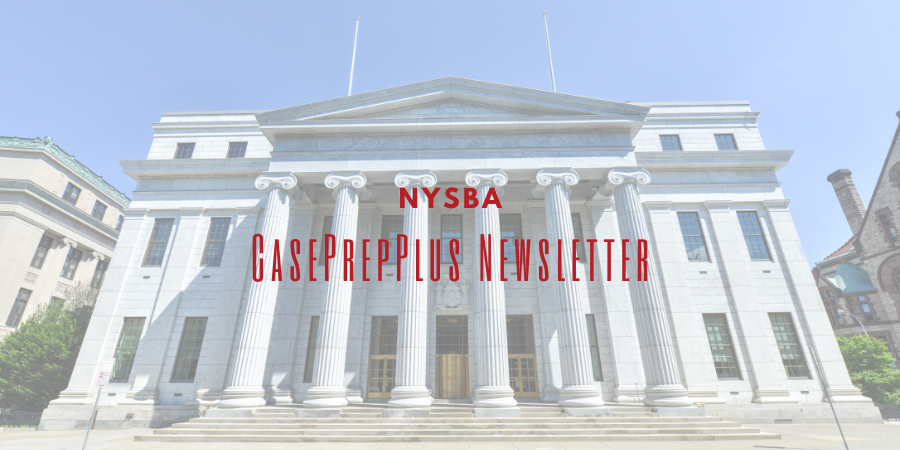
NYSBA CasePrepPlus Newsletter 3.29.24
Can New York’s Extreme Risk Protection Order Statute, Which Temporarily Removes Guns from at Risk People, Survive a Second Amendment Challenge?
The Court of Appeals this week concluded its opinions from the February argument session, but the most interesting cases, to me, came from the Second and Third Departments. In the Second Department, the Court rejected a Second Amendment challenge to New York’s extreme risk protection order statute that authorizes the temporary removal of weapons from a person who is determined to be likely to cause serious harm to themselves or others. And in the Third Department, the Court upheld the City of Kingston’s housing emergency declaration under the Emergency Tenant Protection Act and its rent regulations against a challenge by landlords in the City. Both cases seem likely headed to the Court of Appeals very soon. Let’s take a look at those opinions and what else has been happening in New York’s appellate courts over the past week.
Court of Appeals
Real Property Tax Law, Exemptions
Issue: Is a property owned by a non-profit entity, but leased to a for-profit entity, entitled to an exemption from real property taxes under Real Property Tax Law § 420-a?
Facts: “New York has a longstanding public policy of exempting real property owned by certain not-for profit entities to encourage and foster legislatively favored, publicly beneficial services and operations,” under RPTL 420-a (1) (a). Here, the Department of Finance of the City of New York revoked a RPTL 420-a exemption for a New York not-for-profit corporation after it leased its property to a for-profit corporation. Supreme Court annulled the revocation, holding that the Department “failed to show that it considered whether [the for-profit company’s] service is reasonably incidental to or in furtherance of the exemption purpose” given that [the for-profit company] furthers the charitable activities of Brookdale Hospital and the Nursing Institute.” The Appellate Division affirmed, holding that “the building was exempt under RPTL 420-a because [the for-profit company’s] services are reasonably incident to [the not-for-profit entity’s] purpose of funding and supporting its healthcare affiliates.”
Holding: The Court of Appeals noted that when a municipality that tries to remove a real property tax exemption, it has a heavy burden to show that the owner and users of the land “were not organized or conducted exclusively for exempt purposes or . . . [the land was] not used exclusively for carrying out thereupon one or more exempt purposes.” Evaluating the Department’s findings, the Court held that “the exempt purpose at issue here is that of the property owner—[the not-for-profit entity]—and its purpose is to raise funds, not to provide dialysis services, or even medical services more generally. It is true that Brookdale Hospital and the Nursing Institute provide health care services, but still, the exemption is for [the not-for-profit entity’s] property. And to the extent [the not-for-profit entity] supports the health care efforts of these two entities it does so by fundraising, not by providing direct health care services. If [the not-for-profit entity] engaged in its fundraising efforts in the building, then the exemption would apply to any portion so used, but [it] vacated the premises during [the for-profit company’s] tenancy.” Thus, the Court concluded that the property’s use to provide for-profit dialysis services disqualified it from eligibility for the RPTL 420-a tax exemption.
Favourite Ltd. v Cico, 2024 NY Slip Op 01496 (Ct App Mar. 19, 2024)
Civil Procedure
Issue: Does Supreme Court have discretion to grant leave to amend a complaint under CPLR 3025(b) after the Appellate Division has dismissed the complaint for lack of standing?
Facts: After a dispute between investors in Manhattan real estate and their managers, Plaintiff Upper East Side Suites LLC, a Delaware LLC, commenced an action against the managers for breach of the operating agreement, fiduciary duty, and other claims. Because the managers were removed, there was no longer a registered agent for the LLC, and the Delaware Secretary of State cancelled the LLC’s certificate of formation. The original complaint was dismissed when the LLC lost counsel, but it was permitted to serve an amended complaint. The managers moved to dismiss arguing that the LLC lacked standing or capacity because it had been cancelled. Thereafter, the LLC obtained a new certificate of revival, and cross moved to serve a second amended complaint. Supreme Court denied the motion to dismiss, and granted the cross motion to amend. During the managers’ appeal, they served counterclaims against the plaintiffs, which remained pending while the appeal was decided. On appeal, the Second Department reversed, holding that the LLC had not been properly revived and thus lacked standing and capacity. In its decretal, the Court remanded to Supreme Court for entry of judgment.
Upon remand, the LLC informed Supreme Court that it would again attempt to correct the revival with the Delaware Secretary of State. It did so, and then moved under CPLR 3025(b) for leave to serve a third amended complaint. The managers opposed, arguing that the only was to serve a new complaint was to commence a new action under CPLR 205(a) because the Appellate Division had dismissed the prior complaint in its entirety. Supreme Court granted the motion to amend and serve the third amended complaint. The Appellate Division, in a 3-2 opinion, reversed, holding “that its dismissal of the second amended complaint left Supreme Court powerless to entertain a motion to file another amended complaint, because no complaint remained pending to amend.”
Holding: Reciting the common rule that leave to amend should be freely given, absent prejudice or surprise, the Court of Appeals held “the Appellate Division dismissal of the second amended complaint due to lack of standing or capacity was without prejudice. The order contemplated that the company could ‘in theory, be revived,’ but simply stated that Sirio SRL had done so improperly. Therefore, there is nothing in the Appellate Division’s order or opinion that would prevent plaintiffs from pursuing their claims after curing the standing or capacity issue.” And since the managers’ counterclaims remained pending at Supreme Court the whole time, “Supreme Court retained control over the parties and continued to adjudicate claims related to the same transactions that formed the subject-matter of the complaint . . . Supreme Court [thus] retained the power to grant leave to plaintiffs to file another amended complaint. The mere fact that a complaint is dismissed by an appellate court does not generally imply that the trial court lacks such power. Indeed, we have regularly contemplated the possibility that plaintiffs might replead claims at the trial court after they are dismissed by our court.” As the Court explained, “[o]ur holding is consistent with the general discretion of the trial court to manage its docket in the interest of judicial economy. As Supreme Court observed, there is no reason to require the commencement of a new action, with the associated cost and inconvenience for both the parties and court, where the court already has jurisdiction over the parties in a case on the same subject-matter.”
Urias v Daniel P. Buttafuoco & Assoc., PLLC, 2024 NY Slip Op 01497 (Ct App Mar. 19, 2024)
Torts, Attorney Deceit
Issue: May a Judiciary Law § 487 claim be brought in a plenary civil action where a plaintiff alleges that attorney deceit led to an adverse judgment or order?
Facts: “In 2005, Delfina Urias retained defendants Daniel P. Buttafuoco and Daniel P. Buttafuoco & Associates, PLLC to represent her and her husband, Manuel Urias, in a medical malpractice action stemming from a surgery that left Mr. Urias in a coma.” After a few years of litigation, Urias agreed to settle for $3.7 million. At a hearing to approve the settlement, Urias expressed that she understood the settlement agreement, which contained the “the contingency fee schedule for medical malpractice lawsuits set forth in Judiciary Law § 474-a and stated that expenses and disbursements for expert testimony and investigative or other services properly chargeable to the enforcement of the claim or prosecution of the action would be deducted from the amount recovered.” In a subsequent motion to approve the attorneys fees, Buttafuoco sought a contingency fee based on the separate settlement amount attributable to each of four defendants, rather than on the total settlement amount, which under section 474-a’s sliding contingency fee scale allowed Buttafuoco to claim a higher fee. After analysis, and other proceedings on the fee award, the trial court approved Buttafuoco’s higher fee.
Urias thereafter sued Buttafuoco, “claiming that Buttafuoco had deceived her and the trial court in the medical malpractice action about the legal fees they were entitled to by proffering an ‘illegal’ and ‘improper’ interpretation of section 474-a’s fee schedule.” Urias thus sought to recover damages against Buttafuoco under Judiciary Law § 487. Buttafuoco moved for summary judgment, arguing that Urias’ relief could only be obtained in a motion to vacate the settlement order, and not from a separate plenary action. Supreme Court and the Appellate Division agreed.
Holding: The Court of Appeals held, however, that “section 487 authorizes a plenary action for attorney deceit under these circumstances. The text of the statute allows recovery of treble damages ‘in a civil action’ where ‘an attorney . . . is guilty of any deceit or collusion . . . with intent to deceive the court or any party.’ The phrase ‘in a civil action’ is most naturally read to include a plenary action. Notably, the provision does not differentiate between an action that might undermine or undo a final judgment and one that does not, or between allegations of fraud that are intrinsic to the underlying action, as opposed to extrinsic. Interpreting the statute to permit a plenary action where the remedy would not entail undermining a final judgment (for example, when the deceit harms a prevailing party), but deny one where a final judgment could be impaired, would require us to rewrite the statute. That we cannot do.”
Appellate Division, Second Department
Matter of R.M. v C.M., 2024 NY Slip Op 01545 (2d Dept Mar. 20, 2024)
Constitutional Law, Second Amendment
Issue: Is CPLR article 63-A, relating to extreme risk protection orders prohibiting a person from purchasing, possessing, or attempting to purchase or possess a firearm, rifle, or shotgun under certain circumstances, constitutional on its face?
Facts: The respondent was charged with menacing in the third degree after he brandished a loaded shotgun and pointed it at his neighbor during a verbal dispute. A temporary extreme risk order was entered, under CPLR article 63-a, “based upon a finding of probable cause to believe that respondent is likely to engage in conduct that would result in serious harm to self or others.” Before a hearing on a final extreme risk order could be held, the respondent filed a motion to declare CPLR article 63-a unconstitutional under, among many other provisions, the Second Amendment. “In addition to claiming that the statute violated his Second Amendment right to keep and bear arms, the respondent claimed that CPLR article 63-A was void for vagueness and deprived him of due process of law because no physician’s diagnosis was required for the issuance of an extreme risk protection order.” Supreme Court granted the motion, and declared the statute unconstitutional.
Holding: The Second Department reversed, holding that CPLR article 63-A’s extreme risk protection order scheme, and the procedural safeguards provided, passed constitutional muster. First, the Court explained, medical testimony is not required to make the necessary finding for an extreme risk order—that is, “whether a person has engaged in the type of conduct that evinces a likelihood of serious harm”—because that finding does not require a showing of mental impairment. Rather, the inquiry is a fact-based one that may be made without expert medical testimony. Second, the Court rejected the respondent’s Second Amendment challenge to the law, relying on the Second Circuit’s recent Second Amendment opinion in Antonyuk v Chiumento (89 F4th 271, 307 [2d Cir]), in which the Second Circuit determined that “there is widespread agreement among both courts of appeals and scholars that restrictions forbidding dangerous individuals from carrying guns comport with ‘this Nation’s historical tradition of firearm regulation.” Based on that holding, the Second Department concluded, “CPLR article 63-A imposes a restriction of an individual’s right to own or possess a firearm when there is probable cause to believe that he or she is likely to engage in conduct that would result in serious harm to himself, herself, or others, which is thereafter supported by clear and convincing evidence at a hearing. This regulation is consistent with the Nation’s historical tradition of firearm regulation in keeping dangerous individuals from carrying guns and, therefore, is presumptively lawful.”
Appellate Division, Third Department
Landlord-Tenant, Rent Regulation
Issue: What must a municipality do to declare an emergency under the Housing Stability and Tenant Protection Act of 2019, and then adopt an annual rent adjustment guideline and a fair market rent guideline for the properties subject to the emergency declaration?
Facts: “The Emergency Tenant Protection Act of 1974 was enacted to permit regulation of residential rents for many living accommodations upon the declaration of a housing emergency in New York City or a similar declaration by municipalities in Nassau County, Westchester County or Rockland County.” In 2019, with the passage of the Housing Stability and Tenant Protection Act, “the Legislature allowed municipalities statewide to opt in to the rent adjustment scheme created by the ETPA upon a declaration of emergency due to a housing vacancy rate of 5% or less.” After an extensive housing vacancy study in 2022 that found a 1.57% vacancy rate, the City of Kingston declared a housing emergency within the meaning of the ETPA. Using the rent regulation powers that came with the ETPA housing emergency declaration, the City’s Rent Guidelines Board adopted “n annual rent adjustment guideline and a fair market rent guideline for the properties subject to the emergency declaration,” which provided that tenants could “seek a refund if his or her [fair market] rent increased by more than 16% between January 1, 2019 and July 30, 2022” and required the rent for new leases “between August 1, 2022 and September 30, 2023 be reduced by 15% from the base rate.” Owners of multi-family buildings in the City brought this suit, challenging the emergency declaration and the new rent guidelines. Supreme Court upheld the emergency declaration, but annulled the City’s rent guidelines.
Holding: The Third Department affirmed the City’s ETPA emergency declaration, holding that the City “took a common sense approach, and based the emergency declaration upon a good faith study derived from precise data,” which provided all the rationality that was required to support the declaration. Turning to the City’s rent guidelines, the Court held that the City acted within its powers under the ETPA “to establish annual guidelines for rent adjustments. Nothing in the applicable statutory language explicitly requires that the Board adjust the rent upward rather than downward as petitioners claim, and petitioners’ argument as to why such a requirement should be implied is less than compelling. Moreover, contrary to the apparent conclusion of Supreme Court, the Board was not obligated to conduct a case-by-case assessment of rental units in setting the adjustment guideline, as the statute provides that the adjustment may be applicable for the entire jurisdiction and is varied at the Board’s discretion.”
Appellate Division, Fourth Department
Matter of Rosbaugh (Town of Lodi), 2024 NY Slip Op 01661 (4th Dept Mar. 22, 2024)
Torts, RPAPL 861
Issue: May a municipality be required to pay treble damages for the wrongful cutting and removal of trees from a property owner’s land?
Facts: After the Town wrongfully cut trees from the petitioner’s land, an arbitrator awarded the petitioner “$145,047 for treble the stumpage value of petitioners’ standing trees ($48,349) pursuant to RPAPL 861 (1), plus interest from the date of the award, i.e., May 3, 2021.” In the subsequent CPLR Article 75 proceeding to confirm the arbitration award, and the Town’s counterpetition to vacate the treble damages, the trial court confirmed the award and awarded interest for an additional 10 years.
Holding: The Fourth Department affirmed the award of treble damages against the Town, holding that although “the State and its political subdivisions are not subject to punitive damages and treble damages are generally viewed as punitive . . . , damages awards that include a component of treble damages pursuant to RPAPL 861 (1) are not equivalent to punitive damages.” “RPAPL 861 (1) authorizes a court—or, in this case, an arbitrator—to determine the total amount of compensatory damages to award on a claim for the wrongful cutting and removal of trees by calculating treble the stumpage value of the tree or timber or two hundred fifty dollars per tree, or both, in addition to any permanent and substantial damage caused to the land or the improvements thereon . . . As relevant here, ‘stumpage value’ is limited to only ‘the current fair market value’ of the merchantable lumber within a standing tree . . . ; it does not include the intrinsic value of a tree in its natural state—such as its environmental, historical and aesthetic qualities—which can be substantially greater to a landowner than the mere marketable lumber value.” The arbitrator’s award fell within those guidelines. The Court, however, reversed the additional 10 years of interest awarded, because the arbitrator’s award did not include pre-arbitration award interest, Supreme Court was powerless to award it.

